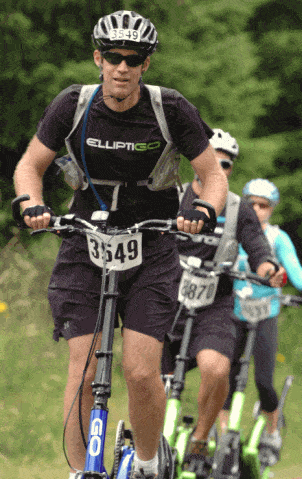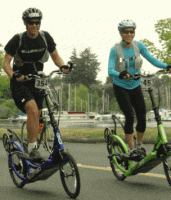Since the ElliptiGO workout experience itself is a combination of traditional running and cycling, our training programs for ElliptiGO elliptical bikes combine elements from traditional running and cycling training programs. We have created these programs based on our combined experience of training for and participating in several distance events and epic rides.
The high mileage recommendations in traditional cycling programs are often too time-consuming for the average ElliptiGO bike rider. Over the same distance, an ElliptiGO bike rider will typically work out more intensely than a conventional cyclist and take longer to cover the same distance. In order to ensure the right level of exertion for proper endurance training, our training programs are built around time or duration of workout rather than strict mileage requirements.
Traditional running programs build in more rest/recovery days and include a longer taper period in the weeks leading up to your event. Because the ElliptiGO elliptical bicycle is a low-impact form of exercise, you will have the ability to train at a higher intensity more frequently than you would if you were running. In our training programs, you will see more frequent workouts and much shorter taper periods than you would with running programs.
You can select and download a program by distance using the links below.
- Ride Your Marathon (26.2 Miles)
- Metric Century (100K or 62.1 Miles)
- Century Ride (100 Miles)
Any questions or feedback for Team ElliptiGO about these training programs? Email us at [email protected]
Feeling inspired to train for an event? Please let us know! In some cases, we may be able to offer you some financial support to partially offset your event entry fees. And we’re always here to help cheer you on and support you as you work towards your goal. For additional tips and advice on training, please read on below.
General Training Advice for ElliptiGO elliptical cycling
Matching Gearing/Cadence To Desired Intensity
It is important to match your cadence and turnover to the desired intensity level of your workout. In general, we suggest the following guidelines for what gears you should be using over various terrain.
8-Speed Models: Use 1-3 for climbing and inclines, use 4-6 for normal riding on flats, and use 7-8 for downhills or for higher-intensity workouts on the flats.
3-Speed Model: Use 1 for climbing moderate inclines; Use 2 for riding on flats; and use 3 for downhills or for higher-intensity workouts on the flats.
In general, you want to aim for a range of 65-80 RPM. For more guidance on riding within the ideal cadence range, download the ElliptiGO Cadence Chart which shows the ideal cadence range across various speeds. A quick turnover or higher cadence will enhance the “running-like” experience of an ElliptiGO elliptical bike workout. You also want to be mindful of what gears you are using on hills/inclines and how that affects the intensity of your workout. Many riders will only be able to climb hills in gears 1 and 2, but others will have the leg strength to use gears 3 and 4 for climbing as well. We recommend experimenting with the range of gears you use on hills and noting how that affects the intensity of your own workout. Then, depending on your training goals and event terrain, you can adjust your training intensity level accordingly.
Hydration on the ‘GO
For any ride over one hour in duration, we recommend bringing water or a sports drink with you to hydrate during your workout. Some people may need hydration for any ride over 30 minutes. Experiment to see what works best for you and remember that your needs may change as weather conditions vary throughout the year. In Team ElliptiGO, we mostly use hydration backpacks like those made by Camelbak or Nathan. Hydration backpacks make it really easy to drink while riding. Other people prefer water bottles that they attach to the ElliptiGO bike stem. In the photo above, Bryan and Erin are carrying hydration packs. In the photo to the right, Steve is riding with a water bottle on the stem.
Nutrition on the ‘GO
The actual calorie burn of an ElliptiGO bike rider will depend on several factors, such as their weight, pace and the amount of wind resistance the rider is confronting. In general, an ElliptiGO rider will be burning approximately 33% more calories than they would riding a road bike at the same pace. To keep your energy up on rides over one hour in duration, again we recommend bringing some water/sports drink with you to stay properly hydrated. It is also helpful to bring some snacks with you to consume along the way and prevent you from running out of energy and “bonking” during your workout. Bars, energy gels and other typical snacks that runners, cyclists and endurance athletes use work great for ElliptiGO riders too. If you carry your food in easily-accessible hydration packs or running belts that have front pockets, you can even snack while you ride. If you carry your food in a back pocket or are otherwise unable to ride while you eat, make sure you stop at least once every hour to consume your snacks and keep your energy up.




4 Responses
[…] een training voor lange-afstand fietsevenementen op de GO. Als het weer wat beter is, ga ik dat trainingsschema maar eens proberen. Vooralsnog haal ik mijn ElliptiGO alleen bij goed weer uit de […]
[…] https://www.elliptigo.com/training-for-long-distance-cycling-events-on-elliptigo/ […]
Seasonal greetings from Trim Co Meath Ireland
Great information- going to start Jan 2023 to undertake a Marathon around Easter
PoD
Thank you so much for posting this information. It’s very timely, since I have signed up for a Metric Century ride, the Tour De Lou in Louisville in April. This will be my first biking event. I’ve always been a runner and have done a lot of 1/2 marathons and 1 full, so training, I’m used to. I’ve been training on some local hills and find that getting my 8C up the inclines is challenging, but doable. I’ll take any helpful hints you want to throw my way. Thanks, Tawnya